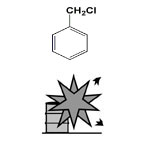| Case Name |
Explosion in the polycondensation reaction of benzyl chloride |
| Pictograph |

|
| Date |
July 29, 1997 |
| Place |
Harima, Hyogo, Japan |
| Location |
Chemical factory |
| Overview |
Benzyl chloride was introduced into the factory without serious safety evaluation, which caused a polycondensation reaction with rust. The result was an explosion accident at a receiver vessel during a preparation process. An incompatible reaction hazard with rust in piping seems to be the origin. |
| Incident |
A receiver vessel for benzyl chloride, which is a raw material of an intermediate used in perfumes or medicines exploded due to an unusual reaction. |
| Processing |
Manufacture |
| Individual Process |
Feed and charge |
| Substance |
Benzyl chloride, Fig2 |
| Hydrogen chloride, Fig3 |
| Type of Accident |
Explosion |
| Sequence |
Methanol and steam cleaning inside the system were carried out after the previous batch. At about 15:00, preparations for start-up had been done by charging 118 L of benzyl chloride into the receiver vessel under reduced pressure (300 torrs). After one hour, white gas with an irritating odor was found coming out from air venting piping, and there was overheating of the receiver vessel as warm as of human skin. The safety supervisor judged that the spouting gas was hydrogen chloride, and tried to deal with it by water sealing with water in a metal drum. As the spouting increased, the hose for the water-sealing treatment could not be held in the place by hand, and eventually the receiver vessel exploded at about 16:17. |
| Cause |
Contamination prevention measures were not taken due to insufficient recognition of the hazard of benzyl chloride. Benzyl chloride was introduced into the receiver vessel under the condition of about 40 °C solution temperature under reduced pressure (300 torrs), without noticing the presence of iron rust in the receiver vessel. It was believed that benzyl chloride went into gaps in the iron rust in a pumice state, and when a polycondensation reaction was started, hydrogen chloride gas was generated and the receiver vessel exploded due to a rapid internal pressure rise. |
| Countermeasures |
Understanding hazardous materials and preventing contamination. The operating manual was reviewed. Preventing injuries. |
| Knowledge Comment |
It is necessary to investigate the incompatible reaction hazard when handling a material beforehand. Simultaneously, it is necessary to examine all foreign materials. |
| Background |
Safety management seems to have been insufficient, because there were imperfections in the performance evaluation and no understanding of the characteristics of benzyl chloride. Although it was the first time benzyl chloride was handled in this factory, required safety evaluation and countermeasure planning had not been done. For example, piping for dropping was filled with iron rust, and the pressure-proof value of the receiver vessel was much lower than the estimated pressure at which polycondensation occurs. |
| Reason for Adding to DB |
Example of explosion caused due to incompatible reaction hazards |
| Scenario |
| Primary Scenario
|
Poor Value Perception, Poor Safety Awareness, Inadequate Risk Recognition, Insufficient Analysis or Research, Insufficient Prior Research, No Sstudy about Reaction Danger, Carelessness, Insufficient Understanding, Insufficient Recognition of Risk, Condensation Reaction, Planning and Design, Poor Planning, Poor Process Design, Bad Event, Chemical Phenomenon, Abnormal Reaction, Secondary Damage, External Damage, Explosion, Bodily Harm, Injury, 5 person injured, Loss to Organization, Economic Loss, Manetary Damage 7 million yen
|
|
| Sources |
Fire and Disaster Management Agency, Explosion in pharmaceutical intermediate manufacturing process of a manufacturer, Accident cases of dangerous materiasl, 1997, pp.100-101.
Fire-Defense Headquarters of the Kakogawa City, Material, Explosion caused by the polycondensation reaction of benzyl chloride., Industry and safety, Vol.14, No.22, pp.14-20(1998)
|
| Number of Injuries |
5 |
| Physical Damage |
A building with a slate roof and facilities partially collapsed. Two buildings of the adjacent office were damaged. Debris such as slates were scattered by the explosion within a 100 m radius, and eight housing units were damaged. |
| Financial Cost |
¥ 7 million. (Fire-Defense Headquarters in Kakogawa City) |
| Multimedia Files |
Fig2.Chemical formula
|
|
Fig3.Chemical formula
|
| Field |
Chemicals and Plants
|
| Author |
ARAI, Mitsuru (Environmental Science Center, The University of Tokyo)
TAMURA, Masamitsu (Center for Risk Management and Safety Sciences, Yokohama National University)
|
|